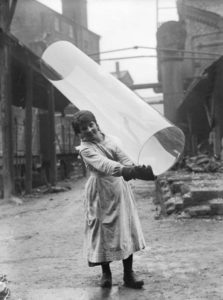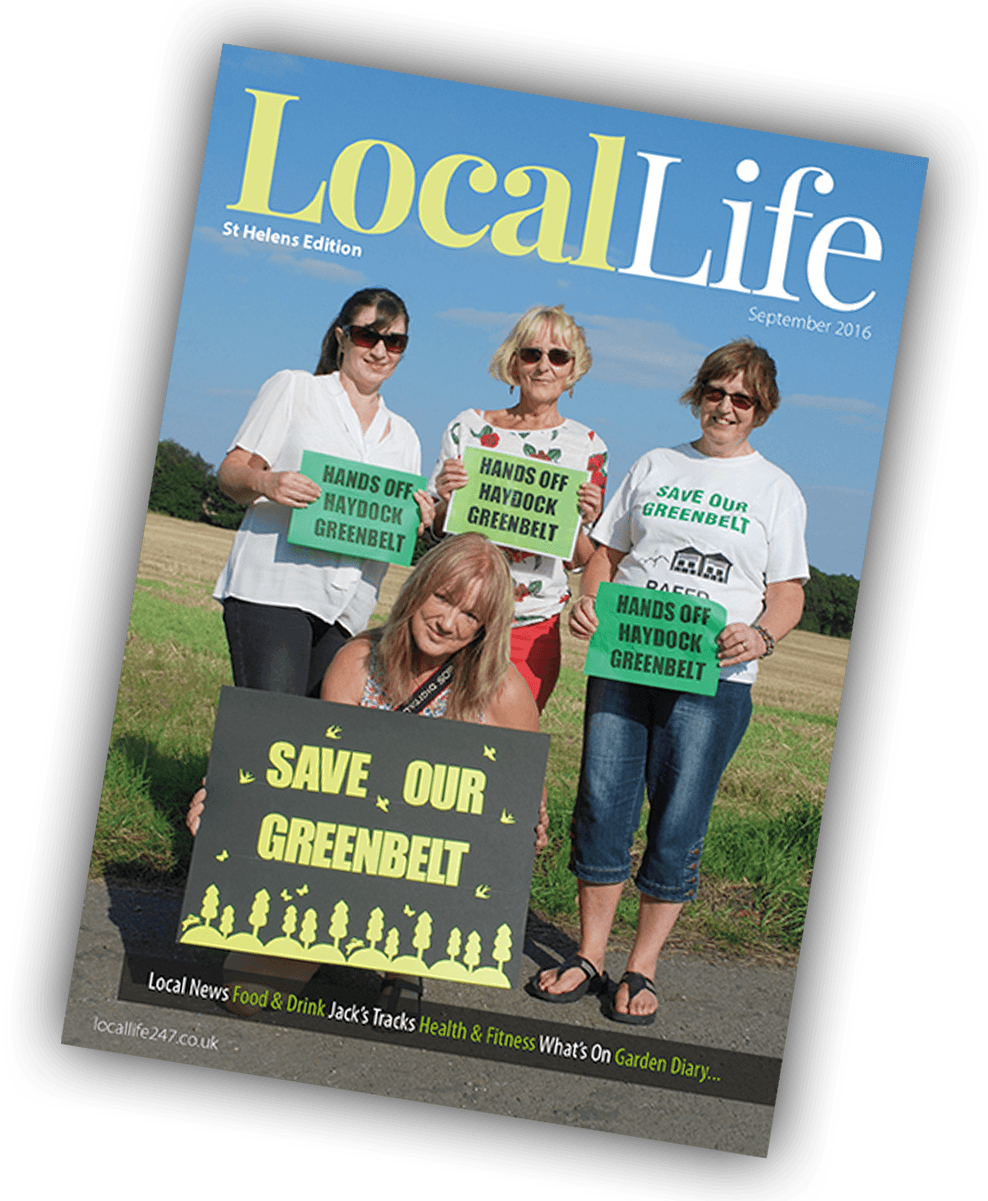
St. Helens glass worker, provided by Imperial War Museum
Cherishing its legacy as a bastion of heavy industry, St. Helens has always sought to highlight its illustrious history prominently. Dotted throughout the borough are a number of historic reminders of the town’s industrial heritage, such as the fascinating World of Glass and the breath-taking Dream sculpture, but there is one site – designated by the Victorian Society as a site of national importance – that has seemingly slipped through the cracks.
While the Pilkington factory continues its production and the World of Glass admits tourists from across the country, another monument to our glass-making heritage – the Cannington Shaw no. 7 bottle shop – has been left, largely, to rot. But the Friends of Cannington Shaw want to bring the old bottle shop’s history back into the public eye – and the building back to life.
The top of the old Cannington Shaw site remains visible from the carpark of Tesco Extra, sitting snug between the trees to the north-west and the Steve Prescott Bridge – you might want to head up here for a better view of the crumbling bottle shop.
The Grade-II listed Cannington Shaw building has been assessed as ‘very bad’ with ‘immediate risk of further rapid deterioration’ by Historic England. In 2017 it was included on the Top 10 Endangered Buildings list by the Victorian Society; all this in spite of its designation as a Scheduled Monument – a ‘protected’ site of national importance.
The story of the bottle shop actually dates back to 1866, when John Shaw went into business with John and Edwin Cannington to establish a bottle factory. Cannington Shaw acquired the Sutton Lodge Chemical Works in 1875 to secure their alkali supply – and the only way to go from there was up. The no. 7 Bottle Shop was finally constructed two decades later in 1886: ten years after the company registered a patent for an improved glass annealing kiln.
Two rival bottle-makers existed in the area then – the Lyon family, who made mineral water and whose business resided in the Thatto Heath Glasshouse, and Nuttalls at the Ravenhead terminus of the Sankey Canal, established around 1845. Cannington Shaw eventually amalgamated with Lyons in 1890, and though Nuttalls employed 450 people under their own steam, they never quite surpassed Cannington Shaw’s impressive figures. In its heyday, the factory had 1,188 employees and was still expanding.
By 1892, Cannington Shaw was the largest bottle manufacturing plant in the UK – some say the world. Part of the Sherdley Glass Works, the factory made use of a Siemens tank furnace heated by producer gas; this melted the glass down to shape it into bottles.
Tragedy came to the bottle shop in 1913, when blacksmith Joseph Haddock was killed while working there. He suffered a fractured skull after being struck on the head by a piece of iron, aged just 40, and died a few days later at St. Helens Hospital; his great granddaughter Brenda Neary has been attempting to look into the accident, without much success.
‘It was incredible how quickly the inquest was concluded,’ Brenda said. ‘I have never been able to track down any documentation other than a small piece in the local paper which said very little. I’ve also tried to track down coroner’s records with no luck.’
Joseph’s son was only two years old when his father died. ‘My great grandma [Joseph’s wife] was a bit of a harridan, a very strong lady who worked hard to bring up her young family alone. She received no state benefits in those days, and as far as I can tell no compensation [for the accident] either’, Brenda continued. ‘She was often quoted as calling her husband “the finest blacksmith in the county”!’
In 1913, Cannington Shaw merged with five other bottling companies – including former rivals Nuttalls – to form United Glass Bottle Manufacturers Ltd (UGB). A gradual increase in mechanisation led to the closure of the factory in 1918, when it was converted into a bottle store, though the UGB continued to operate and acquire more glassworks along the way. During World War II the bottle shop site was used as an air raid shelter, but was afterwards abandoned to the elements.
Other sites have fared better. Pilkington’s offices around the borough, including their former headquarters at Alexandra Park, boast listed statuses and are, for the most part, looked after. Similarly, the no. 9 Tank House – another Scheduled Monument – was incorporated into the World of Glass when it opened in 1999. The tank house and a number of Victorian-era tunnels used in the glass works remain open today for the public to explore as part of the museum.
The no. 9 Tank House was originally part of the Jubilee Glassworks. Opened in 1889 by the Pilkington family, the building housed a Siemens regenerative furnace – a type of open hearth furnace which melted the glass in a brick-lined tank continuously fed with material. The furnaces were revolutionary in their time, saving materials where formerly the glass was melted in large disposable pots that were replaced when exhausted. The new design also saved fuel from heat reuse, making it much more efficient than its predecessors.
If you grew up in St. Helens, chances are you’ve probably heard of the ‘Hotties’, though many seem to dismiss its history as an urban legend. There has been much debate around whether the term refers to the Tank House building itself or to the water pumps coming out of it, but the area is actually famed for the curious phenomenon that lurked in the depths of the Sankey Canal.
The canal was dammed by Pilkington’s to create a reservoir to provide cooling water for the nearby glassworks. The water returned to the canal through spray pumps along the edge of Tank House no. 9, and this unusually hot water raised the temperature of the canal by a considerable amount, making for a great swimming spot after a hard day at the glassworks. It wasn’t until the mid-1960s though that things started to get a bit more ‘tropical’ in the Hotties.
It’s thought that the owner of Owens Pet Shop on Westfield Street dumped his supply of tropical fish in the canal after the shop shut down. The hot water was the ideal location for the fish to thrive, so instead of dying off, a range of species from Guppies to Gudgeon flourished in the Sankey Canal. An article published in 2001 included a comprehensive list of species allegedly found in the canal at the time: this included Tilapia Zilla, Albino Clarius Catfish, Terrapin and… an alligator, though this claim is widely disputed.
While Tank House no. 9 is marked as a heritage site (and for good reason), Cannington Shaw continues to deteriorate. Now most of the roof has caved in, and though a few remnants of the old machinery remain, the building is a shell of its former self – overgrown with weeds, full of crumbling brickwork, loose tiles and collapsed beams protruding from the surviving ceiling. The factory has been photographed by urban explorers, whose forays into St. Helens’ industrial heritage have only revealed more of the sorry state the shop has succumbed to; but that all looks set to change.
In January, the Friends of Cannington Shaw were awarded a grant of £6,800 from the Architectural Heritage Fund. This came as a huge win for the group, who have dedicated themselves to preserving and indeed improving the Cannington Shaw site for over three years. The group also lobbied for the inclusion of the shop on the Victorian Society’s Top 10 Endangered Buildings list in 2017.
Friends Director Caroline Platt felt this victory keenly: ‘We are ecstatic and thrilled to hear this news,’ she commented. ‘The Friends have worked tirelessly to raise the profile of the building – we are looking forward to moving forward in collaboration with Architectural Heritage Fund together.’
Since then, assessors have arrived to evaluate the building’s structural integrity to see what can be done with its remains. ‘We’re continuing to raise the profile of Cannington Shaw with the relevant people’, Caroline explained. ‘We’re working closely with St. Helens Council and the Historical Society – last year we toured local libraries with an exhibition on the old bottle shop, and received a grant of £2000 from Cultural Hubs to help promote our campaign through the arts.’
This funding went towards developing a production of ‘A Day in the Life of a Bottlehand’, which appeared at three St. Helens libraries before showing at The Citadel as part of Heritage Open Days.
Cannington Shaw’s future may still be uncertain, but the Friends are doing their best to save the site and develop it into something that benefits the local community and preserves our glass-making heritage.
Caroline and the rest of the group are always on the lookout for any historical artefacts, accounts or documents pertaining to Cannington Shaw and its history. If one of your relatives worked for the company or later for the UGB, or if you find a glass bottle bearing the company’s mark, you can get in touch on Facebook @CanningtonShaw or email Caroline at caroline@carolineplattconsultancy.co.uk


